|
|
 |
Polycab
Early Polycab models
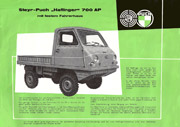
|
The Polyester driver's cab was introduced in about 1960 as a solid, closed cabin which would offer more comfort to the Haflinger driver in cold and wet situations. Also, it comes with a
better sound insulaton than the normal Haflinger version. The brochure shown to the left was a first introdutction to this model.
Das Polyesterfahrerhaus wurde etwa ab 1960 angeboten. Das feste, geschlossene Fahrerhaus bot besseren Komfort bei schlechtem Wetter sowie eine gute Schallisolierung.
Der links gezeigte Prospekt war eine erste Werbung für die neue Fahrerhausvariante.
|
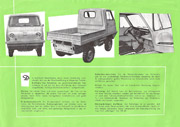
|
The "Polycab", as it is usually called, is a shell construction made of fibreglass mats and polyester resin. The whole cabin was bolted to the normal Haflinger platform.
Usually, this cabin was combined with an Eberspächer heater or with the exhaust heat exchanger system.
Das Fahrerhaus (im Englischen üblicherweise "Polycab" genannt), ist aus glasfaserverstärktem Polyesterharz in Schalenbauweise gefertigt und wurde auf die normale
Haflingerplattform aufgeschraubt. Oft wurde diese Haflingerversion mit Eberspächer- oder Wärmetauscherheitzung ausgeliefert.
|
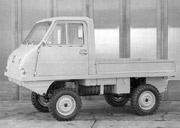
|
The early Polycab model shown in the brochure and in the pictures to the left differs in some details to younger Polycabs. For example, the door windows have a metal frame. Note also
the recess for the door handle, which looks different to the later version. Picture: SDP Archive MIVA.
Die links gezeigte, erste Ausführung des Polyesterhauses unterscheidet sich in einigen Details von der jüngeren Version. Zum Beispiel besitzen die Fenster der Türen einen
Rahmen aus Metall. Auch die Ausnehmung für den Türgriff sieht anders aus als bei der späteren Ausführung. Bild: SDP Archiv MIVA.
|
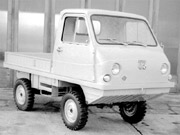
|
In this picture you can see clearly that the early Polycab had no fresh air flap in the front yet. Picture: SDP Archive AQ.
In diesem Bild ist schön zu sehen, dass die frühe Ausführung des Polyesterhauses noch keine Frischluftklappe hatte. Bild: SDP Archiv AQ.
|
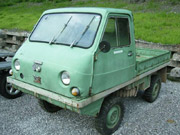
|
What you see here is an early Polycab Haflinger quite similar to the ones above. Not many of this type were made, so they are quite rare today.
Hier ist ein früher Haflinger mit Polyesterhaus zu sehen, ähnlich den oben gezeigten Fahrzeugen. Diese frühe Type wurde nur in geringen Stückzahlen produziert
und ist selten zu sehen.
|
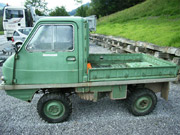
|
Thanks Thomas Danielsmeier for the pictures which he took in Tyrol/Austria.
Danke Thomas Danielsmeier für die Fotos, die er in Tirol in Österreich geschossen hat.
|
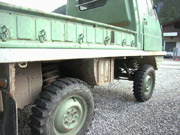
|
Interestingly, it appears the right engine compartment was changed at some stage since it already has the service lid.
Interessanterweise scheint das rechte Seitenblech des Motorraums ausgetauscht worden zu sein, da bereits der Handlochdeckel verbaut ist.
|
Younger Polycab models
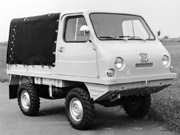
|
This factory photo shows a beautiful, original Haflinger with Polycab from about 1969. Note the fresh air flap just below the Steyr-Puch badge. Also, the door windows have a different frame now.
Picture: Archive Dr. Rudolf.
Dieses Werksfoto zeigt einen schönen, originalen Haflinger mit Polyesterhaus von etwa 1969. Man beachte die Frischluftklappe unter dem Steyr-Puch Zeichen. Außerdem haben
die Türfenster nun andere Einfassungen. Bild: Archiv Dr. Rudolf.
|
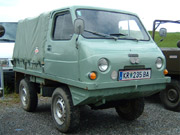
|
Another young Polycab Haflinger which was made in 1974.
Ein weiterer, schöner Polycab Haflinger mit Baujahr 1974.
|
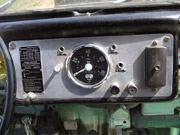
|
Here you see a picture of the centrally mounted dashboard. The knob on the bottom left side opens the fresh air flap.
Ein Foto vom mittig montierten Armaturenbrett des Polyesterhauses. Der Zugknopf links unten öffnet die Frischluftklappe.
|
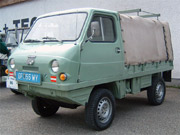
|
A long wheelbase (703 AP) Haflinger with Polycab seen at the Bad Ischl Treffen in 2005.
Ein Haflinger mit langem Radstand (703 AP) und Polyesterhaus beim Treffen in Bad Ischl 2005.
|
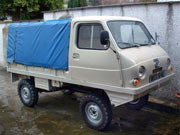
|
This 703 AP is a right hand drive model located in Great Britain. Note that for the RHD version, the horn is mounted on the left side of the cabin.
Dieser 703 AP Haflinger ist eine rechtsgelenkte Version für Großbritannien. Man beachte die Hupe, die auf der anderen Seite montiert ist.
|
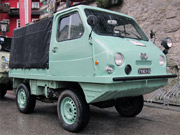
|
Here you see a picture of an Italian Series 1 Haflinger from 1965. Note that the Polycab was fitted with Carello lights for this country.
Hier ein Bild von einem Serie 1 Haflinger aus Italien, Baujahr 1965. Für dieses Land wurden Carello Leuchten verbaut.
|
Kommunalhaflinger
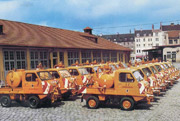
|
Many Haflingers with Polyester driver's cab were used as Kommunalhaflingers (for snow-clearing, street-cleaning etc.). To the left, you can e.g. see the former fleet of the city of Munich.
Since the Kommunalhaflinger is a chapter on its own, I would like to set up an extra page about this Haflinger version in the near future.
Viele Haflinger mit Polyesterhaus wurden als Kommunalhaflinger eingesetzt (zur Schneeräumung, Straßenreinigung usw.). Links zu sehen ist zum Beispiel die ehemalige
Flotte der Stadt München. Da der Kommunalhaflinger ein eigenes Kapitel in der Haflinger-Geschichte darstellt, möchte ich diesem bald eine eigene Seite widmen.
|
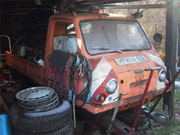
|
Another picture that shows how one of the Munich Haflingers has ended up. Sadly, many Kommunalhaflingers did not survive due to heavy corrosion which resulted from salty winters.
Dieses Foto zeigt das Schicksal von einem der Münchner Haflinger. Leider ist es so, dass viele Kommunalhaflinger aufgrund von Korrosion nicht bis heute überlebt haben.
|
Comments
Here is, where your part of the page begins! If you have anything to contribute, feel free to
add a comment!
At the moment, there exists 1 comment for this page.
 |
 |
|
would like some help finding a couple of things for my haflinger
|
|









